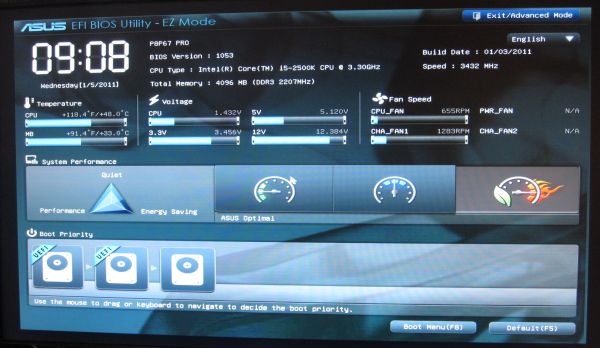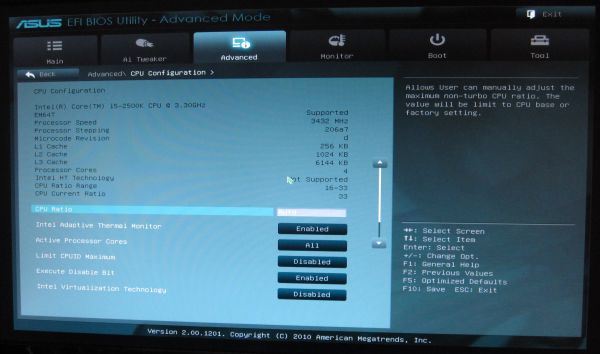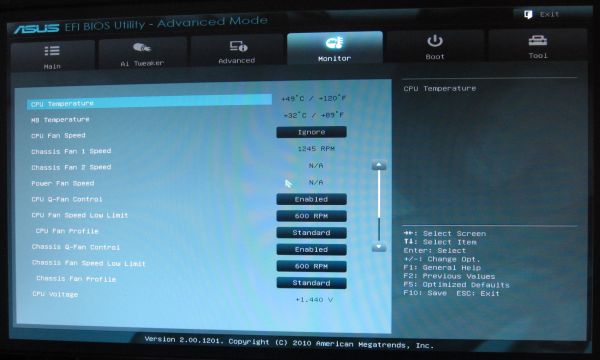The Battle of the P67 Boards - ASUS vs. Gigabyte at $190
by Ian Cutress on January 20, 2011 4:15 PM EST- Posted in
- Motherboards
- Gigabyte
- Asus
- P67
ASUS bring a lot of innovation to the UEFI table over what I have seen from other vendors. The implementation of EZ mode (‘easy’ mode, for us Brits that pronounce that letter ‘zed’) gives the screen below on first entering the UEFI. At a glance, it gives vital motherboard information – CPU, speed, memory, temperatures, voltages, fan speeds, and boot order. The boot order is a great addition, allowing the user to drag-click the order they want. Also available is the three performance options – low power, standard, and performance.
By clicking onto the advanced mode, we get a more BIOS-esque representation of all the motherboard features. The Ai tweaker provides all the overclocking tools we would expect, and more than you find in the Ai Suite in the OS. Features use either a text box for typing values, or a selection box for preset values. The user can utilise the mouse or the keyboard for either task.
Elements such as enhanced sleep states appear under the Advanced CPU Configuration menu, where cores and ratios can be determined. In the Onboard Devices section, if you are not using the Marvell SATA ports, it is advised that this be switched off, to increase boot time by 1-2 seconds.
Fan controls are found in the Monitor tab, where a low limit fan RPM can be given and fan control can be switched between standard/silent/turbo/manual. In manual mode, you can adjust the upper and lower temperature of the fan and at which percentage speed it should run at those temperatures.
Users can specify advanced mode to be shown as soon as the UEFI is selected, and ten UEFI profiles can be saved. The UEFI can also be updated through the Tools tab if the latest file is supplied on a USB drive and plugged in before the ‘update’ option is chosen.
Overclocking
Overclocking on the P8P67 Pro was easy. The UEFI EZ mode offers a performance mode option, which on selecting, enabled the XMP profile of the memory, applied a 103 BCLK, and set the turbo limit to 42x, giving a 4.33 GHz overclock.
As the Ai Suite offers the ‘Auto Tuning’ option, I selected this in the OS and let the program do its thing. After a couple of reboots, and a BSOD, the OS booted into a screen showing a 43x multiplier at 103.5 BCLK (4.45 GHz), and attempted a series of stability tests, slowing increasing the BCLK by 0.5 every 30 seconds. At 105.5 BCLK, a BSOD screen appeared and seemed to crash halfway through, requiring me to reset the system physically. On the next boot, it was stated that the 43x103.5 overclock was applied and now usable. This system is likeable as it promises to adjust depending on how overclockable the processor is.
The downside is that the Ai Suite is quite conservative. I kept with the 103.5 BCLK and went into the UEFI. In advanced mode, adjusting the turbo ratio by one each time and rebooting led to a 46x multiplier (4.76 GHz) successfully passing stability tests. For 47x multiplier (4.86 GHz), I increased the PLL to 1.9V, CPU VCore to 1.42 V, and adjusted the short/long power limits to 150 W/130 W to get a successful stability test pass. This automatically set the memory to a command rate of 3T, so was set back to 1T manually. The 48x multiplier did not boot at this level, and I was not prepared to up the VCore or power limits any more. A 4.86 GHz overclock is very respectable!
At 4.86 GHz (47% OC over 3.3 GHz/non turbo/multithreaded, 31% OC over 3.7 GHz/turbo/single-threaded), the 3D Movement benchmark was run. In single thread mode, a score of 148.92 was achieved, a 31% increase. In multi-threaded mode, a score of 477.60 was achieved, a 37% increase.




















137 Comments
View All Comments
GeorgeH - Thursday, January 20, 2011 - link
On the temperature and power graphs, you might want to differentiate the colors a bit more. Right now it looks like OCCT/Idle are using the exact same shade of purple, and Metro/Video are using the exact same shade of red. Common sense tells me which is which, but it just looks bad.Overall it was a great review; the only thing I'd change would be to put Gigabyte's "BIOS Classic" implementation into the pros column, but I'm weird like that.
Peanutsrevenge - Thursday, January 20, 2011 - link
I have the HTC Hero aswell running Cyanogenmod ROM for 2.2 and the BT Turbo Remote software is showing in my market (version 1.0.9) if you wanna recheck it Ian and update the article.Interesting that you had such trouble with the Gigabyte board, I went off Asus a few years ago due to several glitches, bugs and DOAs and switched to speccing / recommending Gigabyte for friends and customers.
Hope this is a one off for them rather than the end of a faultless era!
sweetspot - Thursday, January 20, 2011 - link
Why do MOBO test sites all fail to add sound quality test to the benchmarks ?? Most folks spending over 150.00 for a mobo and playing games and entertainment, would like nice quality sound as well.Cant spend 190 bucks without asking the sound question, nobody would by a board without the over all picture, not just A wins B in a frames bench test.
Is sound onboard good or not ? do we lose xfire / SLI if we go with add on sound card option . Nobody would buy a mobo without asking that simple question as well, and why does every single review site 99% of the time skip a simple sound quality mention on boards they test ??
No mention of sound quality in a mobo review is just pitifull, cant be that hard to tell someone if it even works or not, alot of boards onboard sound is broken on release, all the review sites always fail to skip that test, so it never gets seen when they give nice review so people go out and buy busted parts.
A simple basic sound paragraph mention as to yes sound in games / videos / chatting were clean and x # of channels responded correctly. Or sound worked but the mic and mic boost options were broken, so dont buy if you online chat which alot of poeple do? How do you skip such a important detail ??
All this was, is a comparison of 190 bucks worth or silence!!
kepstin - Friday, January 21, 2011 - link
If you really care about sound quality, you're probably going to end up using a digital audio output; either co-ax/optical on the motherboard, or via HDMI. At that point it doesn't matter which sound card you have, because you're not using the onboard DAC at all.Rick83 - Friday, January 21, 2011 - link
The quality of the clock generator still matters, though.sweetspot - Friday, January 21, 2011 - link
Not true as the question poised clearly states,Most would think a mobo review would include some sort of sound testing as well as just frames, But no sound quality test or mentions in review of 2 different boards comparison, So review of which is faster but no other quality reasons of the boards are compared aka sound ?? why ??
The cost of extra sound card makes huge difference in product purchases, and not reviewing the key pieces is not helpfull at all in my opinion.
Most readers rely on review sites as they have access to parts a normal user does not get alot of computer parts every day to test with.
This review is a A is faster then B review vs a review like A is better quality / price over all then B review which it seems was intended to be ??
strikeback03 - Friday, January 21, 2011 - link
Both are using the Realtek ALC892, so theoretically should be very similar. I'd agree a "it works" should probably be mentioned, but other than that substantial sound quality testing can be extremely subjective.Hrel - Thursday, January 20, 2011 - link
Are there reviews of the new 15.6" notebooks based on Sandy Bridge with the GT540M and GTX460M coming? You know the ones, from Clevo and Compal with 1080p screens? I've seen them at a couple different places including a very good deal on the GTX460 Clevo from Cyberpower.com. Please please please at least let me know if these reviews are in the pipeline or not.Hrel - Thursday, January 20, 2011 - link
So why is it that as more and more of the load gets put on the CPU, the northbridge, memory controller, GPU, these motherboards are getting more expensive? Seriously? It doesn't make any sense.Is this why Intel is SOOO far behind supporting USB 3.0 and more than 2 measly SATA 6GBPS ports? LGA 775 I had no issue at all getting a very nice board that OC's well and is still running perfectly and while originally supported P4 was updated in the BIOS to support the latest quad core Penryn's on 45nm and it STILL runs like a dream. LGA 1156 I had to just up to the 100-130 range and depending on who I was building for would go up nearing 150.
But now simple things like SLI require a 200 dollar boards? I know that wasn't supported on the other old boards but it's called "progress" for a reason. I consider that a standard feature now not something reserved for rich people. It is unacceptable to pay more than 150 for a motherboard, even if you put bluetooth on it call it the "Royal Excaliber 12000" and have a prince sign it. Seriously, I didn't expect to see prices over 200 at all till X68 came out. WTF guys, WTF!
MeanBruce - Thursday, January 20, 2011 - link
Royal what? I used to have a patient named Royal Ruffles, his real name, so peculiar I thought, oh yeah back to mobos. So interesting some readers think it's stupid to spend $200 for a new mainboard while others have no problem dishing out $430 or $450. I mean we are enthusiasts right? It's tax deductible, so I am all for drooling over new Z-branded chipsets and LightPeak support and 16GB of quad memory and incorporated northbridge and overclocking it all with your iPhone. It's a hobby right? It's supposed to be a blast!